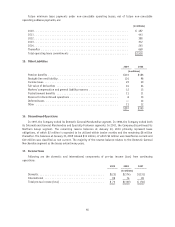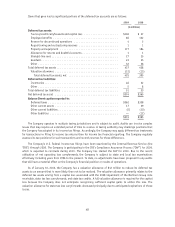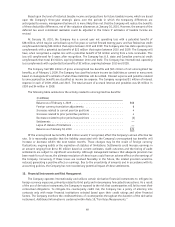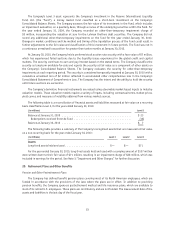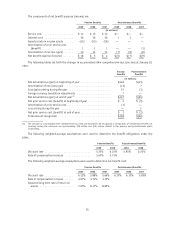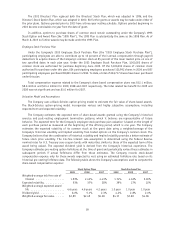Foot Locker 2009 Annual Report Download - page 68
Download and view the complete annual report
Please find page 68 of the 2009 Foot Locker annual report below. You can navigate through the pages in the report by either clicking on the pages listed below, or by using the keyword search tool below to find specific information within the annual report.Derivative Holdings Designated as Hedges
For a derivative to qualify as a hedge at inception and throughout the hedged period, the Company formally
documents the nature of the hedged items and the relationships between the hedging instruments and the
hedged items, as well as its risk-management objectives, strategies for undertaking the various hedge
transactions, and the methods of assessing hedge effectiveness and hedge ineffectiveness. In addition, for
hedges of forecasted transactions, the significant characteristics and expected terms of a forecasted transaction
must be specifically identified, and it must be probable that each forecasted transaction would occur. If it were
deemed probable that the forecasted transaction would not occur, the gain or loss would be recognized in
earnings immediately. No such gains or losses were recognized in earnings for any of the periods presented.
Derivative financial instruments qualifying for hedge accounting must maintain a specified level of effectiveness
between the hedging instrument and the item being hedged, both at inception and throughout the hedged
period, which management evaluates periodically.
Cash Flow Hedges
The primary currencies to which the Company is exposed are the euro, the British pound, the Canadian dollar,
and the Australian dollar. For option and forward foreign exchange contracts designated as cash flow hedges of
the purchase of inventory, the effective portion of gains and losses is deferred as a component of accumulated
other comprehensive loss (‘‘AOCL’’) and is recognized as a component of cost of sales when the related inventory
is sold. The change in AOCL related to such contracts was a decrease of $3 million for the year ended January 30,
2010 and a $1 million increase in AOCL for the year ended January 31, 2009. Cost of sales was reduced by
approximately $2 million for both 2009 and 2008 as a result of settling these derivative contracts. The ineffective
portion of gains and losses related to cash flow hedges recorded to earnings was not significant for any of the
periods presented. When using a forward contract as a hedging instrument, the Company excludes the time value
from the assessment of effectiveness. At each year-end, the Company had not hedged forecasted transactions for
more than the next twelve months, and the Company expects all derivative-related amounts reported in
accumulated other comprehensive loss to be reclassified to earnings within twelve months.
Net Investment Hedges
The Company has numerous investments in foreign subsidiaries, and the net assets of those subsidiaries are
exposed to foreign exchange-rate volatility. In 2005, the Company hedged a portion of its net investment in its
European subsidiaries by entering into a 10-year cross currency swap, effectively creating a €100 million
long-term liability and a $122 million long-term asset. During the third quarter of 2008, the Company terminated
this hedge by amending its existing cross currency swap and entering simultaneously into a new cross currency
swap, thereby fixing the amount owed to the counterparty in 2015 at $24 million. In 2006, the Company hedged a
portion of its net investment in its Canadian subsidiaries. During the fourth quarter of 2008, the Company
terminated this hedge and received approximately $3 million.
The Company had designated these hedging instruments as hedges of the net investments in foreign
subsidiaries, and used the spot rate method of accounting to value changes of the hedging instrument
attributable to currency rate fluctuations. As such, adjustments in the fair market value of the hedging
instrument due to changes in the spot rate were recorded in other comprehensive income and offset changes in
the euro-denominated net investment. Amounts recorded to foreign currency translation within accumulated
other comprehensive loss will remain there until the net investment is disposed of.
The amount recorded within the foreign currency translation adjustment included in accumulated other
comprehensive loss on the Company’s Consolidated Balance Sheet decreased shareholders’ equity by $15 million,
$15 million and $20 million, net of tax at January 30, 2010, January 31, 2009 and February 2, 2008, respectively.
The effect on the Consolidated Statements of Operations related to the net investment hedges was not
significant for the year ended January 30, 2010, represented $3 million of expense for 2008, and represented
$1 million of income for 2007.
50








